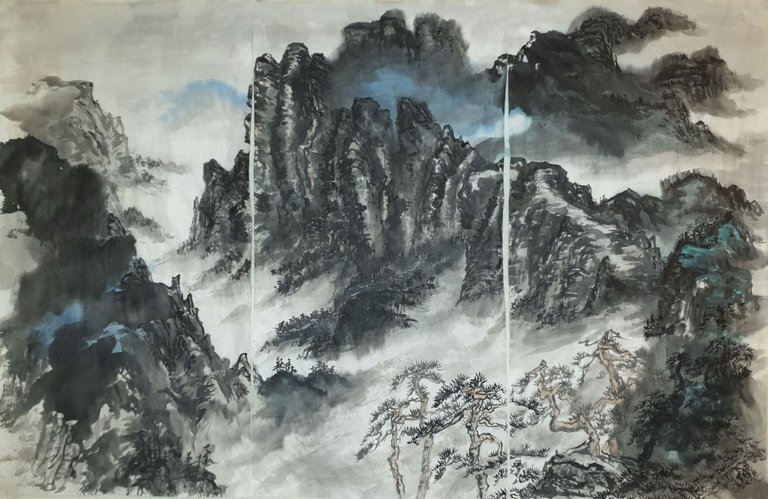Guo Xi 郭熙, during the eleventh century, and in his "Linquan gaozhi" 《林泉高致》 writes:
A mountain seen up close has one aspect, and it has another a few miles away, and yet another one from further away. Its shape changes with each step. The front view of a mountain has one view, another view from the side and another from behind. Its appearance changes from every angle, as many times as it does the point of view. So, it is necessary to realize that a mountain combines in itself several thousand shapes.
山近看如此,远数里看又如此,远十数里看又如此,每远每异,所谓山形步步移也。山正面如此。侧面又如此,背面又如此,每看每异,所谓山形面面看也。如此是一山而兼数十百山之形状,可得不悉乎?
Reading this passage, it is evident that en plein air painting, and the Albertian perspective is not a suitable mean to represent mountains or nature in general, and as a unifocal gaze is totally inadequate. Therefore, to represent a complex subject such as the mountain, first of all, a process of study and assimilation of the subject is necessary, and only then will it be possible to represent it through a painting. Another implicit aspect in these lines is that this painting will not consider only a portion of the territory, but it will attempt to express the totality of the subject, precisely through the use of different perspectives. Sight is a means of knowledge of the subject and one of the rules to be followed in the representation, but not the only one. The skill of the painter lies in being able to harmonize different points of view and different perspectives in a single work, making it harmonious and natural in the eyes of the observer.
In order to be able to express the richness and variety of his subject, the artist needs a deep knowledge of it, which it will not be possible to acquire through a single point of view, but needs a more complex and profound relationship with the environment and nature. For this reason, many of the greatest mountain and water painters in Chinese history embraced a life outside the cities and from the centres of political activity, to move to the solitude of the mountains and live in close contact with the subject of their art. In any case, the visual experience is an important aspect for the artist in order to represent his subject.
The obstacles when visually approaching the natural environment is a problem that has been treated since the time of the first theoretical texts on mountain and water painting. The first systematic theoretical text Introduction to Painting of mountain and water 《画山水序》 by Zong Bing宗炳 dates back to the first part of the fifth century. In this early treatise we see already how the only use of the sight to perceive and depict mountains and waters is a limitation, a partial understanding. The primary problems dealt with were the proportions of the various subjects and the possibility of representing vast distances on small surfaces such as those of pictorial support. The reflection on proportions is very important, in fact in texts related to painting we do not find statements like "what is close is large and what is far away is small, in proportions of its distance from the observer", a rule that is at the base of the unifocal perspective. There are statements like those of Wang Wei 王维 in the treatise On mountains and waters 《山水论》, which quotes: "a mountain measures a zhang, a tree a chi, a horse a cun, a man a fen", "丈山尺树,寸马分人" , therefore by physical measurements (expressed in different measure units) are applied in painting. Afterwards he proceeds on to giving practical indications on how to paint distant subjects: “distant men have no eyes, distant trees have no branches, distant mountains have no stones, so they should be painted like indistinctive eyebrows; the water in the distance cannot see waves, so they should be connected with clouds and sky "," 远人无目,远树无枝,远山无石,隐隐如眉;远水无波,高与天齐 ". In these passages we see how the author never talks about the change in size and proportions of what was being observed, because a tree near or far in reality always has the same height, its shrinking is an illusion. The difference in size of the subjects within the work is only partially related to the proximity or distance factor, there are other factors that compete for it. These other factors follow the expressive needs of the artist, which elements he wants to give relevance to and which less, and how these elements relate to each other within the painting, between main and secondary subjects, following the natural relations between them. The differences in size of the various subjects are not in relation to the observer or the painter of the scene, but are in relation to each other, Guo Xi writes: "a mountain that rises in its size becomes the master of the other peaks developed around it, it becomes the centre of attraction of the elements that surround it. Whether large or small, distant or close, like a king receiving homage from his courtiers ","大山堂堂为众山之主,所以分布以次冈阜林蟹,为远近大小之宗主也。其象若大君 赫然当阳,而百辟奔走朝会,无僵塞背却之势也 。" It is the same concept expressed in a more concise way by Wang Wei: "First, the orientation and height of the main mountain must be determined, then follow the peaks that surround it ", "定宾主之朝揖,列群峰之威仪".

Giacomo Fumo - Everlasting Mountains - 70x100, ink on Xuan paper, 2020
https://saurosefolli.wixsite.com/giacomoshan/selezione-di-lavori
wow, outstanding!
@tipu curate
Upvoted 👌 (Mana: 36/48) Liquid rewards.